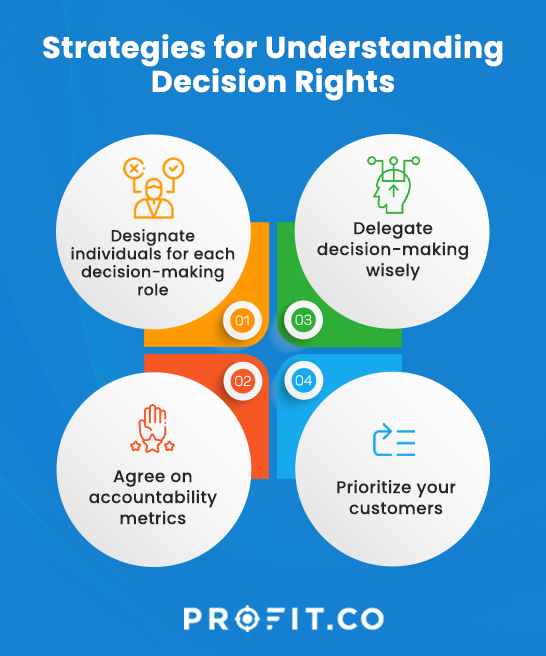Introduction
Decision clarity in an organization requires two essential parts: knowing what decisions to make and who should make them. Decision rights often belong to the C-level management team, but competent employees can have decision rights depending on the tasks. Organizations can enhance their efficiency and ensure optimal outcomes by implementing a systematic approach to decision clarity.
This guide shows the connection between decision rights and clarity, with tools and strategies to make the best business choices.
What are Decision Rights?
Decision rights are a company’s rules or procedures that enable transparent decision-making. These guidelines inform the organization about who makes decisions, what decisions to make, and how info rights flow, e.g., from external industry experts, internal data analysis, decision-making meetings, etc. Organizations must explicitly state their decision rights to empower their teams, encourage transparency, and streamline workflows.
Why is Clarifying Decision Rights Crucial for Businesses?
Decision rights and clarity empower businesses to make improved and expedited decisions that yield tangible results. By establishing clear decision-making structures and defining the authority of individuals or teams, organizations can enhance their ability to navigate complex choices efficiently.
Decision rights provide a framework that ensures the right people are involved in enabling decision-making, leveraging their expertise and knowledge. This targeted involvement allows for more informed and insightful decisions. When decision rights are clearly defined, it reduces ambiguity and enables individuals to take ownership and responsibility for their choices.
More specifically, decision rights help a company to:
- Generate a healthy debate in a psychologically safe workplace environment
- Respond quickly to internal and external challenges
- Avoid bottlenecks between leadership and employees, departments, and functions
- Use precise language and decision-making terms that everyone agrees upon
Whenever you see a successful business, someone once made a courageous decision.
Top Questions to Consider Decision Making
Having a clear understanding of decision rights is indispensable for attaining successful outcomes.
If you want to understand the decision rights framework in your business, ask yourself the following questions:
- Who owns decision outcomes?
- How are decision outcomes measured and evaluated?
- Where and when are the decision outcomes evaluated?
- How does the organization share these outcomes transparently?
For example, suppose a company wants to improve efficiency through integrating a CRM system. In that case, the decision rights process includes:
- Identifying a project manager for implementation
- Establishing performance metrics and milestones
- Opening communication channels at every step
- Evaluating the implementation for success and learning opportunities
Embrace the power of decision rights and OKRs to unlock your team’s full potential
Why do Companies Face Challenges in Getting Clarity on Decision Rights?
Establishing decision rights and clarity is a complex process that often overwhelms managers. It goes beyond assigning a team leader and holding progress meetings.
The main challenges with getting clarity on decision rights include:
1. Mistaking decision rights with workflows or organizational structure
Making decisions solely based on the hierarchical position of individuals may not always yield the best results. Evaluate employees based on their qualifications, expertise, and experience rather than solely relying on rank or seniority. By recognizing that decision-making proficiency can exist at various levels of an organization, businesses can tap into a broader range of perspectives and expertise, leading to more effective and well-informed decisions.
2. Overlapping responsibilities in large organizations
In complex organizations, there can be a tendency to prioritize decision-making with reduced accountability over ensuring the accuracy and effectiveness of choices. This trade-off between speed and thoroughness can compromise the quality of decisions. Organizations can make timely decisions while ensuring they are well-informed, sound, and aligned with the desired outcomes.
3. Conflicts of interest
Leaders who prioritize personal benefit over the collective interest can resist any initiatives aimed at achieving decision clarity as a means to evade accountability. By obstructing efforts to establish transparent decision-making processes, they aim to shield themselves from taking responsibility for their actions. When fostering a culture of decision clarity, it is essential to promote ethical leadership that prioritizes the organization’s welfare and encourages accountability at all levels.
4. Poor organizational culture
Decision clarity is often hindered in businesses that cultivate an environment of unhealthy competition, impunity, and knowledge silos. Such practices undermine the transparency and collaboration necessary for effective decision-making. Organizations can break down these barriers by encouraging cooperation, accountability, and knowledge sharing and creating an atmosphere conducive to decision clarity.
What is a Decision Matrix and How to Use it?
A decision matrix is a tool that effectively weighs your outcomes based on established criteria. It requires a scale to rank importance, e.g., 1 = low impact and 5 = high impact. If a decision has three potential outcomes, assign a number to each and choose the most desirable results. Use a decision matrix to narrow down to one solution out of multiple options and variables, e.g., during market analysis, choosing product features, or risk assessments.
What are the Decision Rights Tools Available?
Depending on your context, you can try other decision rights tools besides the decision matrix. These tools include:
- RACI (responsibility, accountability, consultation, information)
- RAPID (recommend, agree, perform, input, decide)
- OVIS (own, veto, influence, support)
Determining the appropriate tools for decision rights is crucial because they are not universally applicable but customized to suit specific organizational needs. It is important to recognize that decision-making processes may vary depending on the context, and finding the right tools is essential in effectively managing and allocating decision rights within an organization.
What are the Strategies to Understand Decision Rights?
Once you determine your decision rights framework, how do you ensure clarity?
Here are some strategies to consider:

1. Designate individuals for each decision-making role
Incorporating the RACI framework as an example, assigning a leader for each role is essential. When defining responsibilities within this framework, it is crucial to determine who holds the ultimate decision-making authority, whom to consult for expertise and input, and who will benefit from the decision. Simplifying decision rights in this manner enhances transparency within the organization.
2. Agree on accountability metrics
It is essential to identify specific outcomes that can indicate success or failure and establish a straightforward evaluation process for them to achieve decision clarity. Utilizing tangible metrics, such as percentage change in sales, customer satisfaction, or efficiency, can significantly facilitate decision clarity. These metrics provide concrete and measurable indicators, making it easier to assess the impact of decisions and determine their effectiveness. Organizations can enhance their decision-making processes by outlining how to evaluate these outcomes and ensure a more transparent and results-oriented approach.
3. Delegate decision-making wisely
Ensuring the empowerment of frontline teams to make everyday operational decisions is crucial for organizational success. Having a well-defined decision rights framework is equally important. Without clarity, there is a risk of confusion in the flow of information and decision-making authority from top management to the frontline. Organizations can foster a more efficient and effective decision-making process at all levels by establishing a clear decision rights framework.
4. Prioritize your customers
It is crucial to recognize the importance of employees who directly engage with customers and provide them with a voice in decision-making processes. Granting these teams the right to make choices that directly impact clients is essential. Additionally, it is valuable to consider their experience and feedback as you evaluate and prioritize your strategic initiatives. By incorporating their insights, organizations can make more informed decisions that align with customer needs and preferences, improving customer satisfaction and business success.
FAQs
1. What are decision rights examples?
Decision rights examples include identifying frameworks around budget allocation, digital transformation, recruitment, sales strategies, and other critical business operations.
2. What are decision rights tools?
Decision rights tools are systems businesses use to outline their decision-making process, e.g., RACI, RAPID, and OVIS.
3. What are the benefits of decision rights?
Decision rights bring clarity and transparency into an organization by outlining everyone’s roles, powers, and responsibilities.
Conclusion
Remember, decision clarity is an ongoing process that requires continuous attention and refinement. Organizations can promote effective decision-making and achieve better outcomes across all company levels by following the strategies and utilizing the tools outlined in this guide. To achieve accountability in their operations, organizations can adopt various decision-making strategies. However, the critical foundation for successfully implementing these strategies lies in leveraging decision rights and promoting clarity. By harnessing decision rights and ensuring clarity within your organization, you can streamline your business processes and pave the way for success.




